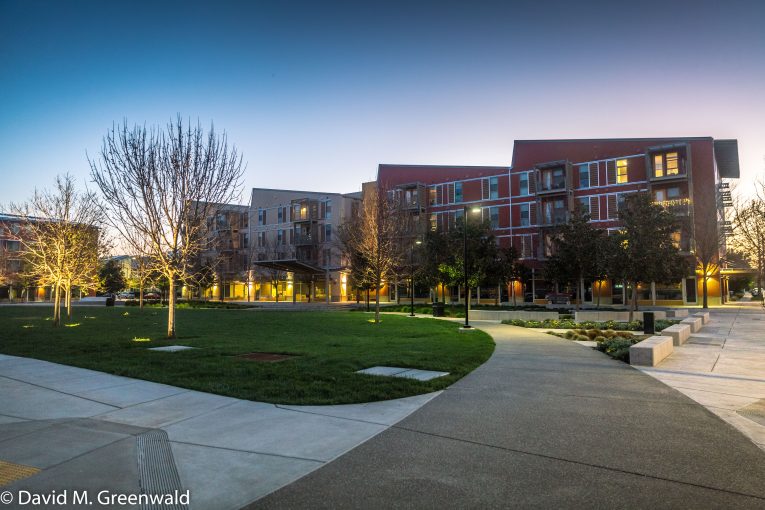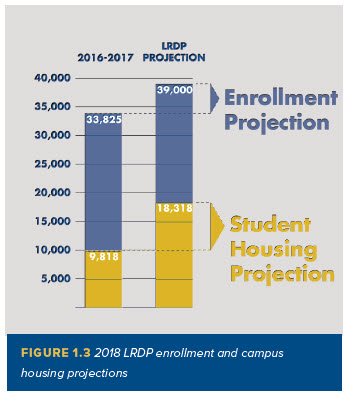

It has been a long process which first began in late 2015, but on Friday the university released its Long Range Development Plan (LRDP) along with its Draft EIR to assess the potential environmental impacts of the new housing projects. Public comment is now open until May 29.
The key highlights of the LRDP include another surprise. The expected campus population growth will remain the same as previously described, with enrollment by the end of the LRDP growing to 39,000.
The employment projected is roughly 14,500, an increase of 2000 employees over current numbers.
According to the LRDP, “The LRDP employment projection is 14,500 employees, an increase of approximately 2,000. Three factors may lead to potential growth in employment: (1) increased enrollment would require additional faculty; (2) increased research initiatives would require additional faculty as well as professional researchers; and (3) growth in the campus population would increase the number of support staff affiliated with academic and student life programs, as well as the stewardship of campus infrastructure and management of campus resources.”
What is new is that the LRDP is now planning on accommodating 9050 new on-campus student housing beds. This reflects the previously agreed to construction of 8500 additional beds of new  student housing under the 2018 LRDP and “occupancy of 550 additional beds at West Village that resulted from allowing doubling in existing apartments.”
student housing under the 2018 LRDP and “occupancy of 550 additional beds at West Village that resulted from allowing doubling in existing apartments.”
That means with campus enrollment projected at 39,000, “the projected new housing would result in more than 48 percent of students living on campus.”
In the 2016-17 academic year, there were about 9,800 students living on campus.
“The 2018 LRDP would accommodate approximately 18,800 students in campus housing, compared to a current capacity of approximately 9,800 students,” the Draft EIR Notice of Availability (NOA) stated.
While that is not the 50 percent that some have asked for – it is creeping that much closer.
The LRDP EIR and the LRDP have “no height limit for student housing and we will continue to push for higher densities on less land.”
The DEIR identifies “the expected/typical range of environmental impacts and our continuing efforts to mitigate those impacts where feasible.”
The university stated, “Including the West Village Expansion and Orchard Park projects as project-specific analysis within the LRDP DEIR helps accelerate these two projects for 5,200 beds of student housing for early delivery in the LRDP period. Of the 8,500 beds of new construction in the 2018 LRDP, these first projects are targeting occupancy for 5,200 students as early as Fall of 2020.”
The EIR addresses the potential project-specific environmental effects associated with two student housing components of the 2018 LRDP: the West Village Expansion component and the Orchard Park Redevelopment component.
The West Village Expansion “would provide additional students for approximately 3,800 students north of Hutchison Drive and west of Celandon Street in the West Village neighborhood on the  west campus at UC Davis.”
west campus at UC Davis.”
It would take place on 48 acres with 1.3 million square feet of new student housing buildings along with 800 spaces of automobile parking with additional on-street parking.
The West Village Expansion component also includes a remote parking area located on approximately 20 acres immediately south and east of I-80 and adjacent to Old Davis Road.
Meanwhile, the Orchard Park component south of Russell and east of Highway 113 is located on 19 acres of land.
These facilities would include two separate types of housing: (1) 200 student family housing units (apartments), and (2) approximately 1,200 additional beds for graduate, transfer, and undergraduate students.
Student family housing would, according to the NOA, be located in the southeastern portion of the site while student apartments would be located in the northern portion of the site, closer to Russell.
The project envisions around 642,000 sf of new student housing to be constructed for a total of 555 housing units.
“Internal roadways within the Orchard Park site would allow for safe passage of one vehicle in each direction and shared bicycle access. Additionally, approximately 480 parking spaces would be provided for student vehicles, as well as one bicycle parking space per resident. It is anticipated that solar photovoltaic would be provided within surface parking lots and could also be provided on rooftops of on-site structures,” the NOA states.
In a university release, it states, “The goal of the new LRDP is to plan for future growth in programs while providing a sustainable community where people can live, learn and grow. The plan identifies likely needs over a horizon of more than ten years and designates areas of the campus for functions including housing, research facilities and other services while targeting environmental goals in areas such as energy and water use, transportation and waste management. It does not commit UC Davis to specific projects, but currently planned and future development projects, including on-campus housing, will depend on the approval of the plan’s environmental impact report.”
Matt Dulcich, director of environmental planning for UC Davis, described the LRDP as a key component for building the campus of the future.
“We’ve put a lot of work into planning how UC Davis will grow and thrive into the future and we’re looking forward to getting feedback from the community,” Mr. Dulcich said.
—David M. Greenwald reporting


For public comment:
Draft EIR Public Review and Comment Period
The public review period for the Draft EIR begins on Friday, April 13, 2018 and ends on Tuesday, May 29, 2018 at 5:00 p.m.
The purpose of the public review period is to provide the public an opportunity to review and comment on the 2018 LRDP Draft EIR. Please send your written or electronic responses, with contact information for your agency or yourself, to the following address:
Matt Dulcich, AICP
Director of Environmental Planning
Campus Planning and Environmental Stewardship
University of California, One Shields Avenue
Davis, CA 95616
environreview@ucdavis.edu
Public hearing scheduled:
Thursday, May 3, 2018 starting at 7:00 p.m. in Room 1310 of the UC Davis International Center located at the corner of California Avenue and Russell Boulevard on the UC Davis campus.
Thanks, Don for the PSA…
Those that don’t review and respond, via writings or attending/speaking @ the public meeting, within the alloted time, “… should forever hold their piece (peace)…”
Just saying… fully knowing that some will take ‘late hits’ much later…
Key point to reiterate – there’s been a lot of talk about number of beds and not enough about the affordability of those beds. The will be a key thing I am looking at in the process – whether these beds will be reasonably affordable.
True… important as to LRDP (which UC gets to decide on)… but not a CEQA matter… that issue shoud be raised as part of the LRDP, as comments/concerns/views… not the CEQA document(s)…
True
Please understand, that I understand, and support the importance of the issue of affordability… was speaking as to “venue”… folk with concerns, on either, should make their views/oncerns/objections known… within the time frames provided… in the proper ‘venue(s)’…
I was speaking to the LRDP rather than the EIR
Understood… hope all folk reading this thread understand, and take heed of this conversation…
Seemingly a low parking-to-bed ratio is fine BUT why any private cars at all, except for people with ADA-related exemptions? True, the cars won’t be used on campus, but they will be used to go through campus and to the vast majority of commercial destinations/districts in Davis outside of campus where parking is “free” – even much of Downtown will in the near future only be time-restricted.
Students drive a lot when they don’t have to pay for parking. OK, perhaps this is a question, fine. Get a group of students together: If one doesn’t feel like riding a bike they’ll drive. They’ll drive from West Village to Downtown to see a movie. They’ll drive to Target. They’ll drive to Trader Joe’s and so on… right? Surely we can figure out a way to quantify this as we do the same for travel to campus?
Every surface parking spot costs at least $5,000. For the West Village expansion along that’s $4,000,000 for one lot. Yes, over a number of years they could pay it off. No, not every bike is a “car”*. But how about if instead all that $$$ goes to buy, cargo-optimized electric assist bikes for students? Perhaps 1,600 of them? (A few less if some more expensive ones are acquired for carrying a student’s young family). Part of the outside furnishing in their apartment, for lack of a better term. Used while they’re at school here, then handed over to the next people… two full bags of groceries, even a case of beer. Not a problem.
* Consider “automobile” a technical term, and “car” more like e.g. “…. you need a car!” So the goal of a bike or a bike + train or even just feet in a dense, fully-equipped neighborhood is to be a car, or a car-like car. Something that does what a car can do, yes? You grok?
Please use your opportunity to comment to UCD on the LRDP.
No one here can help with your issues…
> No one here can help with your issues…
Applies to most Vanguard commenters, no?
It is interesting that David is pushing to make the new housing more affordable and Todd an others are pushing to make it less affordable by charging for parking.
P.S. Since Davis is flat I don’t understand why anyone (who has both legs and is not disabled) needs an “electric assist bike”…
re: choking for snarking (i.e. not charging for parking)
Who pays it? You? No. City of Davis residents? No, but YES! Since they’ll have to deal with the movement of those cars. Should student fees pay for it? How can that be fair since only – okay, thankfully – a minority of them will have cars to use?
I want to make housing affordable by bringing it closer to destinations and without any real need for private automobiles. In the case of these slightly-more peripheral developments.. well, it’s a helluva lot better than living in the next towns over, but still it’s too far to walk to shop for basics.
Which brings us to the e-bikes. When it’s hot, when you’re tired, when you’ve got to get to class quickly from off-campus, when you want to arrive less sweaty, carrying a bunch of cargo (starting from a dead stop takes a lot of energy before momentum comes into effect… ) very much when you’re cycling into a headwind combined with one or more of those factors. Many of these are the reasons why about 1/3 of new bikes sold in also very flat but generally much cooler Netherlands are e-bikes. That’s why I am happy we’ll have e-bike share here, though they’re not set up to carry much cargo… perhaps the new owner of Jump Bicycles – a small start-up you may have heard of – likes it this way so you’ll their use services when you need to carry more than a bag of groceries?
> I want to make housing affordable by bringing it closer to destinations
I think you’re on to something: solar mobile housing — bring the housing to the destination!
> Since Davis is flat I don’t understand why anyone (who has both legs and is not disabled) needs an “electric assist bike”…
Amen.
More the danger of a motorcycle, less of the benefits of a bicycle.
> danger
It’s as dangerous as a bicycle with a strong wind behind it.